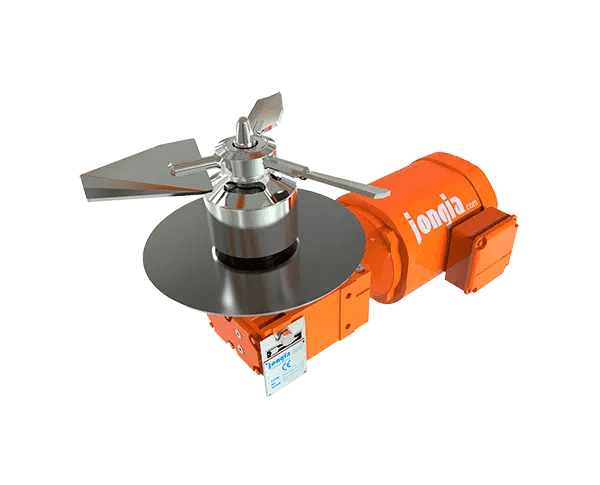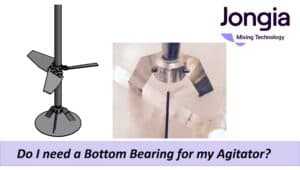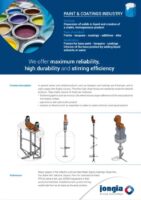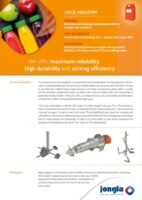Light Duty Bottom Entry Agitators
Types: JMB
Light duty bottom entry agitators and mixers are the best fit for applications like keeping dairy products homogenous and vegetable oil or juice storage.
These applications are characterized by:
- Fluids which are easily mixed or kept homogeneous
- Small tank volumes
- Low viscous fluids
- Tanks with low pressure (max. 10 bar g)
- Temperatures from -20 °C to 150 °C
- Generated torque relatively low

| Light Duty Bottom Entry | |
|---|---|
| Motor power | 0.25 kW – 4 kW |
| Materials | Stainless Steel 304, 316 L, Duplex (Super), Hastelloy C4 or C2000, Titanium Grade 2 or 7 |
| Coatings | C3, C4, C5 of C5M |
| Surface wetted parts | Ground until Ra < 0,4 µm, handpolished till <0,2 μm or electropolished |
| Explosion proof (ATEX) | Ex zone 0, 1 or 2 for gas, 21 or 22 for dust or Non-Ex version |
| Accessories | Direct or gear driven (all brands), all kinds of sealing systems, adapted flanges to vessel, welded or bolted versions |
JMB mixers – magnetic mixers

The JMB type of Jongia’s Magitator is suitable for bottom mounting. A unique design in durability and hygiene, which meets the most stringent CIP and SIP requirements according to EHEDG and FDA/EC1935:2004 guidelines. The Magitator can be used in hermetically closed vessels or systems without the need of complicated rotary seal and is practically maintenance free. The open construction of the mixing head ensures an optimum flow for easy cleaning and efficient mixing.
This design of mixer which operates at a torque of approximately 40 Nm and is very suitable for mixing of different liquids with a maximum viscosity of around 800 Mpas.
Applications Light Duty Bottom Entry Agitator – JMB
Frequently Asked Questions
What are light duty bottom entry agitators used for?
Light duty bottom entry agitators are ideal for applications like maintaining the homogeneity of dairy products and storing vegetable oils or juices. They work well with low viscous fluids in small tanks and can handle low pressure and varying temperatures.
What types of materials are used for these agitators?
The agitators are constructed using stainless steel (304, 316 L), duplex (super), Hastelloy, or titanium. These materials are chosen for their durability and corrosion resistance, making them suitable for various industrial applications.
What is the torque generated by the JMB mixers?
The JMB mixers operate at a torque of approximately 40 Nm, making them effective for mixing different liquids, even those with a maximum viscosity of around 800 mPas.
Are these agitators suitable for explosion-proof environments?
Yes, the agitators come in explosion-proof versions compliant with ATEX, suitable for Ex zones 0, 1, or 2 for gas, and zones 21 or 22 for dust. Non-Ex versions are also available.
How are the wetted parts finished?
The wetted parts of the agitators are finished to specific standards: ground to Ra < 0.4 µm, hand-polished to <0.2 µm, or electropolished, ensuring hygiene and ease of cleaning for various applications.
Contact our specialized team for all your questions

Tom Pruymboom
Sales Director
Area Worldwide

Bart Brouwer
Area Sales Manager
Area Worldwide
Related Articles

Do I need a Bottom Bearing for my agitator?
Do I need a Bottom Bearing? The installation of a bottom bearing is not mandatory. While it offers certain advantages, there are also drawbacks to consider. It is important to note that the bottom bearing functions more as a displacement

Fermentation & Bioreactor Mixing Process
Bioreactors and Fermenters are culture systems to produce cells or organisms. They are used in various applications, including basic research and development, and the manufacturing of biopharmaceuticals, food and food additives, chemicals, and other products. A broad range of cell types and organisms can be cultivated in bioreactors and Fermenters, including cells (like mammalian cell lines, insect cells, and stem cells), microorganisms (like bacteria, yeasts, and fungi), as well as plant cells and algae. The words “Bioreactor” and “Fermenter” are basically the same thing.

Biodiesel blending with zero leakage!
Fuel blending is a critical component of biodiesel production. A properly blended fuel can increase energy efficiency, reduce emissions and improve performance. However, it can be difficult to achieve consistent fuel quality during blending due to differences in storage tanks,





